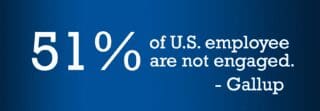Want top performers? Prioritize the employee experience

When is the last time you took an assessment of your team’s engagement? Are you the type of manager that constantly thinks about this? Or have you not revisited this topic since the last employee engagement survey? There’s no wrong answer but there may be an opportunity for you to transform how you approach employee engagement.
For starters, employee engagement is not about employees’ happiness levels as it’s possible to have a highly satisfied team that produces mediocre results. Think about it: what employee wouldn’t report high levels of satisfaction if they’ve got a “good gig” with a nice manager and low to no performance expectations placed on them?
While ensuring that your team is happy and fulfilled is part of the job of a good manager, employee engagement efforts should focus on engaging employees and driving results.

A recent Gallup survey revealed that 51 percent of U.S. employees are not engaged. That number should alarm you. Essentially, one in two of your employees are not reaching their potential. But before you think all is lost, adjust your outlook and view this an opportunity to transform your strategy. As a leader you should always remember that employees want to be inspired.
More and more companies are revamping their employee engagement approach by shifting to strategies that focus on the employee experience. And with good reason: when brands moved from a customer-satisfaction outlook to focusing on the overall customer experience, they benefitted with loyal customers and learned more about customer expectations.
Companies that focus on the employee experience will reap the rewards that come from an engaged workforce, like lower turnover, increased profitability, less absenteeism, higher customer ratings and an overall commitment to quality from employees.
But what does it take? How can companies turn around the culture by prioritizing the employee experience?
- Know where you want to end up. Just like any other mission, know your goal. What do you want to happen? Then, determine how to get there. Share this goal with the team, clarify your expectations of the team, keep the team updated on progress, make sure everyone has the tools needed to accomplish their part, listen to team feedback and tweak as needed.
- Let people pitch in. Again, people want to feel connected to something bigger than just their role. In this case, assign them a piece of the plan to show them how their piece is a part of the big picture.
- Provide development opportunities. When employees feel they’ve stopped growing, they’re more likely to leave the company. Hold on to top performers by making their development a priority. With them, seek opportunities for continued learning and help them advance when an opportunity to be promoted appears.
- Practice mindful management. As a manager, ask yourself where there’s room for improvement in how you manage. Could you communicate more effectively? Do you take other people’s work styles into consideration? Are you truly available to your team? Do you contribute to the culture you’d like to create – or do you detract? Consider the role you play.
- Value authenticity & transparency. Gone are the days of one-way communication from managers. Today’s thriving workplaces are focused on two-way communication that’s honest and authentic. Managers are letting teams in on the business strategy (and their personal selves) and co-workers are collaborating and forming genuine relationships. All of this is leading to positive results and an enhanced workplace experience.

One of our clients, Hilldrup, celebrates and thanks its employees for their hard work just ahead of the company’s peak season with a cookout. - Bring on the surprise & delight. Just as it sounds, surprise and delight elements are fun and special ways to say thanks to your team. Perhaps you’ve reached a goal or the team has been hard at work to hit the numbers, let them know the hard work is appreciated with a mid-day ice cream social, an impromptu brewery outing or an early-close day.
Having a culture of engagement is no longer a perk when it comes to hiring and retaining top performers. Candidates are doing their research and investigating the internal culture of a company more than ever before. Without focusing on the employee experience, companies will continue to lose out on hiring top performers and retaining champions who leave simply because they’re not feeling valued and recognized. It’s never too late to take an honest assessment of your culture and develop a strategy that puts people first and delivers results.

Leave a Reply